[ 1-19 ]|[ 20-39 ]|[ 40-59 ]|[ 60-79 ]|[ 80-100 ]

Vision for orientation and mobility is also vision for physical education. Child's O&M instructor is the person who knows at which distance the child notices important landmarks, in severe visual impairment windows, open doors, people passing by and how well the child can use auditory information for orientation in space.
Children who do not move are assessed for their ability to orient within the space where they can reach for things. Children who use wheelchairs are a special group in O&M because they may need to plan their routes for much longer distances than walking children and thus may need to learn to use telescope and to know the maps even better than other children with visual impairment.
Spatial orientation needs to be trained using "little rooms" still in school age if the child is severely multidisabled.
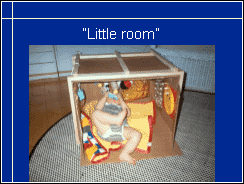
In this slide we see an infant in a little room made of a regular brown box. It trains integration of spatial information from vision, echoes and tactile and kinaesthetic perception and at the same time is an effective way to support development of object permanence.

Although our main interest is in the assessment of today's situation, we need to ask, whether there is enough vision for the development to the next level of performance and if not, does the child have compensatory techniques to reach that level using them. If the child does not have the compensatory techniques then special training in that area will become a part of the child's learning plan.
Children with motor problems require special attention because their behaviour may deviate from normal either based on unusual visual information for planning movements, unusual strategies in performing movements or abnormal visual feed-back during movements. We will discuss this question also later during the third lecture.
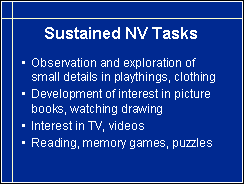
Structure of central visual field for sustained near vision tasks like reading and writing is usually the function that is best assessed during clinical investigations. However, at school we need even more detailed information, some of which we will gather observing the child's performance in exploring details, learning to read, reading errors, eye-hand coordination. Information on the development of visual functions of the central vision depicts both the quality of vision itself, quality of visual devices given to the child and quality of low vision training before school age.
We will discuss visual field for reading in lecture nr 3.
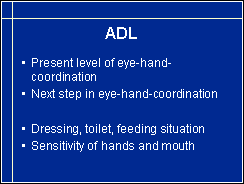
Vision for activities of daily life or daily living skills is mostly testing eye-hand coordination but also that of functional visual field. Both the present level and techniques to reach the next level are considered.
The most motivating situations to observe are often dressing, independent or supported use of toilet (many school toilets are problematic because of lack of contrast) and feeding situations.
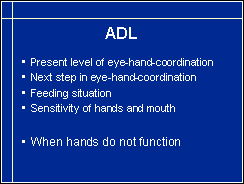
During observation we should be aware of possible tactile problems in hands or in mouth. Many children with brain damage have hypersensitive hands and mouth, which may make their use for exploration nearly impossible. Some children have loss of tactile, kinaesthetic and haptic information of their hands (stereoagnosia), which is a serious complication because we all learn to use our vision by combining information from vision with information from hands and mouth.
Mouthing is sometimes taken as a sign of autism in visually impaired children when it is not known that severely visually impaired, emotionally stable adults use the tip of their tongue to explore details that are too small to be felt with finger tips.
When hands do not function we need to modify assessment of vision to use what ever strategy the child has to reply.
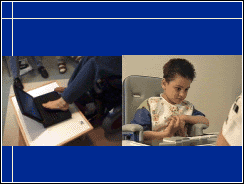
When the hands do not work, often also speech and other motor functions are involved. When a child cannot use hands or voice, writing the answers on a computer is a possibility. However, the working distance is very long for a visually impaired child and requires auditory output to facilitate communication.
If the child can use gaze and head movements for pointing, testing is almost as easy as when a child can talk.
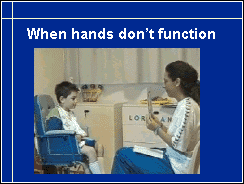
As we see in this short video, contrast sensitivity with the Hiding Heidi test, perception of expressions with Heidi Expressions test and perception of size with the LEA rectangles can be assessed when the child uses gaze pointing and pointing with his head. At the end he also tries to use his hand to point. When he looks to the side he is looking at his father for confirmation that he is performing well. (See the video.)
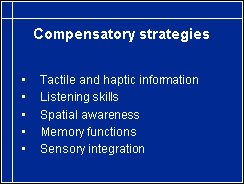
It has been mentioned several times that compensatory functions need to be assessed as an integral part of evaluation of vision. Tactile and haptic information of hands, listening skills and hearing, spatial auditory and visual awareness, visual memory functions (without which recognition, re-cognition, is not possible) and sensory integration require targeted observations and test situations.
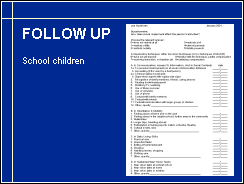
During the school years assessment of functional vision and compensatory techniques need to be repeated at regular intervals, so that teaching and learning techniques can be adjusted to meet the needs of the child. The frequency of assessments depends on whether the condition is stable or vision is improving or decreasing. This list was written for well functioning school children in Kenya. Since more than 60 per cent of visually impaired children have at least one additional impairment or chronic illness, this follow-up list needs to be modified for each child to cover functions that are important to train as a part of his/her special education.

|

|
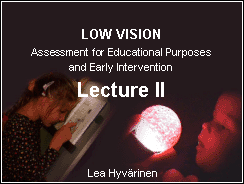
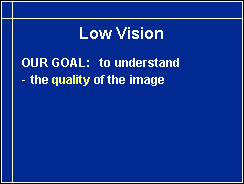
|
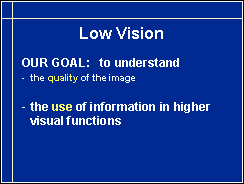
|
| Slide 35. | |
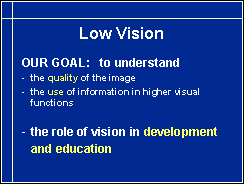
|
|
Our goal in the assessment is understand what and how the child perceives world so that we can plan teaching and learning techniques to fit the needs of the child.
Visual impairment is often taken as "eye impairment", i.e. only disorders of the eye and optic pathways are considered in clinical evaluation. However, vision is a brain function and should be assessed as brain function. There are two different parts in visual perception:
- quality of the image coming to the visual cortex
- quality of higher visual functions in the visual associative cortices.
Both parts need to be evaluated, especially in all children with known brain damage.
Vision is a learned brain function. Some visual functions are present at birth but most visual functions are learned during the preschool years. Therefore we need to know how and what the child has learned to understand how vision has affected and will affect development of the child and our planning of special education.

|

|
| Slide 38. | |

|
|
Each visual image is based on three components: perception of forms, colours and movement. These three components need to be assessed. Additionally we need to know the size and quality of the visual field, visual adaptation to different luminance levels and child's oculomotor functions.
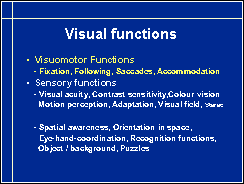
Based on the information that we have from the child's ophthalmologists we now observe the visuomotor abilities of the child: fixation, following movement (that can be compensated with head movements), saccades that some children compensate with head movement, although this is not an easy way of reading. Last but not least, accommodation during sustained near vision tasks. If the child becomes tired during near vision tasks, his near vision acuity measured at the same distance as before, may start decreasing. That reveals that the child cannot accommodate a longer time but needs to wear reading lenses.